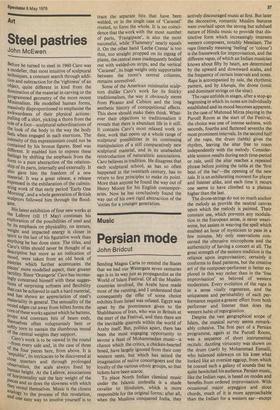Music
Persian mode
John Bridcut Sending Magna Carta to remind the States that we had our Watergate seven centuries ago is in its way just as propagandist as the World of Islam Festival. Of all the Muslim countries involved, the Arabs have made most of the running, and I understand that consequently the offer of some choice exhibits from Israel was refused. Egypt was upset by the prominence given to the Shahbhanou of Iran, who was in Britain at the start of the Festival, and then there are the inevitable quarrels within the world of Araby itself. But, politics apart, there has been the most engaging opportunity to savour a feast of Mohammedan music—a chance which the critics, a chicken-hearted breed, have largely ignored from their cosy western nests, but which has seized the imagination of native concertgoers and the loyalty of the various ethnic groups, so that tickets have been scarce.
To place North Indian classical music under the Islamic umbrella is a shade cavalier to Hinduism, which is more responsible for the original forms; after all, when the Muslims conquered India, they
actively discouraged music at first. But later the decorative, romantic Muslim features were overlaid upon the strong but subdued nature of Hindu music to provide that distinctive form which increasingly interests western composers, notably Messiaen. The raga (literally meaning 'feeling' or 'colour') is the framework for improvisation, and the different ragas, of which an Indian musician knows about fifty by heart, are determined by the upward and downward scales, and the frequency of certain intervals and notes. Raga is accompanied by tala, the rhythmic pattern, and by kharaja, the drone (tonic and dominant strings on the sitar).
The raga unfolds in stages, after a stop-go beginning in which its notes are individually established and its mood becomes apparent. In the case of Mahmud Mirza playing in the Purcell Room at the start of the Festival, the choice was one of intense sadness, with seconds, fourths and flattened sevenths the most prominent intervals. In the second half of the raga, the drum (tabla) gives the rhythm, leaving the sitar free to roam independently with the melody. Considerable tension results during each time-period or tala, until the sitar reaches a repeated phrase before joining the tabla at the 'first beat of the be—the opening of the new tala. It is an exhilarating moment for player and listener alike, and each time it recurs one seems to have climbed to a plateau higher than the last.
The drone-strings do not so much anchor the 'melody as provide the neutral canvas upon which the melody is painted. Their constant use, which prevents any modulation in the European sense, is never wearisome, but assists in weaving the spell which enabled an hour of mysticism to pass in a few minutes. My only reservations concerned the obtrusive microphone and the authenticity of having a concert at all. The great strength of the eastern tradition is the reliance upon improvisation; certainly it conforms to fixed patterns, but the creative art of the composer-performer is better explored in this way rather than in the 'free improvisation' so beloved of western modernists. Every evolution of the raga is in a sense vitally regenerate, and the uniqueness and perishability of each performance require a greater effort from both performer and listener than does the western habit of regurgitation.
Despite the vast geographical scope of Islam, the musical survey seems remarkably cohesive. The first part of a Persian programme, again at the Purcell Room, was a sequence of short instrumental recitals: dazzling virtuosity was shown on the drum (zarb) by Mohammad Esmaili, who balanced sideways on his knee what looked like an oversize eggcup, from which he coaxed such a galaxy of sounds that he quite bewitched his audience. Persian music, like the Indian raga, is based on modes and benefits from ordered improvisation. With occasional major arpeggios and stout chords, much of it is more approachable than the Indian for a western ear—except
for the use of the voice, which, coming from the back of the throat, is as raw as any in an Isfahan bazaar.
The second part was a combined performance (much in rondo form) for various lutes, the zarb, the santour (precursor of the cimbalom), the kamanche (a type of viol with an almost spherical belly) and the ney (a wooden straight reed flute with no mouthpiece). Here was considerable levity and bonhomie—no surprise in so urbane a people as the Persians—which offset the rather narrow emotional base of some other Islamic music. The audience was in ecstasy, and I hope the cries of 'Encore' long outlast that particular evening.



































 Previous page
Previous page